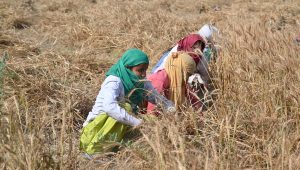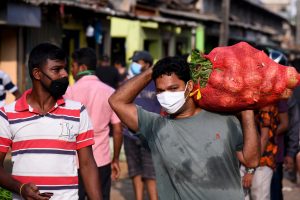Agricultural policy in the shadow of pandemic: Whence and whither?
India’s economy has been severely affected as a result of the COVID-19 lockdowns and subsequent restrictions on non-essential economic activity. However, the agricultural sector is projected to grow at the rate of 3% in the coming year, and food production has remained adequate so far. Several agricultural reforms have been introduced in this period, including the easing of restriction on intra-state trade and the provision of credit to farmers. In this blog, Dr. C. S. C. Sekhar, Professor at the Institute for Economic Growth, outlines these reforms and discusses additional short- and long-term complementary measures that can be undertaken to strengthen their impact. As always, implementation of proposed reforms remains key. Kalyani Raghunathan, series co-editor and Research Fellow, Poverty, Health, and Nutrition Division (PHND)

Prayagraj, Allahabad: Farmers harvest wheat crop during the government-imposed nationwide lock down to contain COVID-19. Shutterstock/ Prabhat Kumar Verma
The COVID-19 pandemic has severely affected countries around the world and is likely to have a serious impact on the Indian economy as well. In early April, the International Monetary Fund forecasted a decline of 3% in the world GDP for 2020-21. India’s growth was projected to be slightly better at 1.9%. However, this forecast for India has since been downgraded by various rating agencies.
Amidst this mayhem, agriculture has remained a bright spot and is projected to record a growth rate of 3%in 2020-21. Coming on the heels of decent agri-GDP growth of 3.7% in 2019-20, this achievement is remarkable, particularly at a time, when other sectors of the economy are reeling under the impact of the lockdown. The food production is robust, harvesting and procurement are brisk, stocks are adequate, even with enhanced food distribution programs, global stocks and food production scenario are promising and domestic production outlook for the upcoming season is upbeat. In addition, policymakers have turned the crisis into an opportunity to usher in long-term reforms in agriculture. We discuss briefly the performance of agriculture during the pandemic, describe the reforms undertaken, and round off with steps needed.
Performance of agriculture
There is a bumper production of staple cereals in the country, with early estimates for 2019-20 projecting a wheat and rice output of 107 and 118 million tons, respectively, which is five million tons more than what it was in 2018-19.Wheat procurement has been brisk at 32 million tons, despite limited availability of labor and machinery. The crop outlook for the upcoming kharif season also appears positive with several encouraging pointers. Grain stocks with the Food Corporation of India (FCI) on 1 April were 57 million tons, which were about two and a half times the buffer stock norms at the time and adequate to meet the requirements. The expected procurement in the current rabi season is about 51 million tons, while the outgo on all the programs, including the recently announced free grain distribution program of 5 kg per person (for regular beneficiaries as well as migrants) will be 31 million tons until July. Hence, by the beginning of July, the stocks could reach a comfortable level of 77 million tons, as against the buffer norm (for July 1) of 41 million tons.
FCI has dispatched nearly 6 million tons of food grains to the states in the month of April, which is double the usual monthly dispatch. Almost all states have completed their offtake of food grains, demonstrating the urgency required in dealing with the situation. Thus, the physical availability (production and stocks) of staple cereals and their distribution to the states is satisfactory. However, the same is not true of many other commodities, especially horticultural commodities that suffered due to disruptions in transport networks and closure of cold storage facilities and markets. Sugar and milk consumption declined due to closure of hotels and restaurants during the lockdown period. Poultry prices also plummeted due to COVID-19 fears.
On the demand side, incomes of farmers of perishable crops and poultry products suffered due to crop losses, issues relating to storage and distribution, and fall in prices caused by lack of demand. Farm labor earnings were severely hit because of restrictions on movement and subdued agricultural activity. The complete halt on construction activity, which absorbs most of the surplus agricultural labor, further exacerbated the crisis. This huge negative impact on rural incomes is bound to have an adverse effect on the economy, which was already reeling with demand contraction before the onset of this crisis.
Reforms in the stimulus package
The measures announced by the Finance Minister, as part of the stimulus package for agriculture on May 15, are very encouraging. First, the removal of restrictions under Essential Commodities Act (ECA) should help attract private investment in agriculture, and help farmers of cereals, pulses, oilseeds, onion and potato, who had been severely hampered so far. Second, the proposed enactment of a central law to allow inter-state trade should provide more options to farmers. Although agriculture is a state subject, the Government of India is authorized to make a law using the provisions of entry 33 of the Concurrent List of the Constitution of India, related to trade in food articles, oilseeds, cotton and jute. Third, the setting up of INR 1,00,000 crore (US$13.3 billion) fund to improve farm-gate infrastructure for post-harvest operations should benefit farmers of perishable crops. Lower interest rates and capital subsidy may also be needed, similar to the support provided to the dairy sector during the ‘White Revolution’. Finally, the extension of INR 2,00,000 crore (US$26.51 billion) credit to farmers under the Pradhan Mantri Kisan Samman Nidhi (PM-KISAN), fishermen and those engaged in animal husbandry, and provision of INR 30,000 crores (US$3.98 billion) of additional refinancing facility by NABARD and several other measures for animal husbandry and fisheries are positive steps toward long-term growth of the agriculture sector. However, implementation is key in ensuring success of these reforms.
Way forward
Short-term
A judicious mix of policies, combining direct payments to farmers and rural labor, with free food provision, in addition to providing employment under MGNREGA, is needed to ensure economic and physical access to food for the vulnerable population. The quantum of assistance and the coverage of beneficiaries for direct benefit transfers in the first stimulus package need to be expanded.
Cash transfers to farmers under the PM-KISAN program are hardly adequate. The weighted cost of cultivation (using area under the crops as weights) is more than three times the current assistance of INR 6,000 per year, according to draft estimates by the Institute of Economic Growth. Also, there are nearly 7.6 crore active MNREGA job card holders and about 1.36 crore seasonal migrants who need direct cash transfers to cope with income shocks caused by the lockdown. Tripling payments under PM-KISAN and providing direct payments of INR 2,000 each to MGNREGA active card holders (approximately 10-day wages) and seasonal migrants involves an expenditure of INR 70,060 crores (US$9.3 billion), which is about 0.4% GDP of the country. In addition to direct transfers, employment needs to be provided using MGNREGA to the surplus rural laborers (due to reverse migration) by modifying the guidelines of the scheme and allowing them to work on private lands for agricultural operation. Part of the wage payments can be made under MGNREGA, and the remaining by the farmers.
Long-term
A few structural reforms are also needed to take full advantage of the reforms ushered in the stimulus package. First, land leasing regulations need to be relaxed in consultation with states to allow economies of scale to farmers. Second, a move away from the price-based support system to a fixed direct income-based system for non-staple food commodities is recommended, thus providing much-needed basic income to farmers, without affecting marginal production and with fewer market-distortions. At the same time, continuing minimum support price (MSP) procurement for staple cereals, and extending it to pulses, is needed to build the necessary stocks for Public Distribution System and food emergencies, if any. Third, the preparation of region-specific long-term plans for agriculture and rural development is called for, as was done in some states, by integrating agricultural growth with farm and non-farm employment to reduce migration.
In conclusion, although agriculture has been performing better than other sectors during this crisis, and current reforms are a move in the right direction, a few complementary measures are needed to solidify its impacts. We hope that the recommendations outlined in this blog can aid policymakers to strengthen India’s agricultural systems and make it resilient to the consequences of the ongoing pandemic.
Dr. C. S.C. Sekhar is Professor of Economics, Institute of Economic Growth, University of Delhi. The analysis and opinions expressed in this piece are solely those of the author.
This blog has been published as a part of the International Food Policy Research Institute (IFPRI), South Asia, blog series on analyzing the impacts of the COVID-19’s pandemic on the sub-national, national, and regional food and nutrition security, poverty, and development. To read the complete blog series click here
New research from a Special Issue of Applied Economic Perspectives and Policy
The pandemic caused disruptions to both the supply of and demand for health services that persisted past the lifting of lockdown measures.
Public food transfer programs have traditionally been the most common social protection programs in Bangladesh


